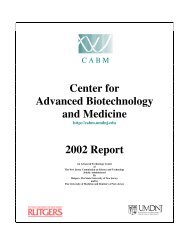Annual Report 2011 - Center for Advanced Biotechnology and ...
Annual Report 2011 - Center for Advanced Biotechnology and ...
Annual Report 2011 - Center for Advanced Biotechnology and ...
Create successful ePaper yourself
Turn your PDF publications into a flip-book with our unique Google optimized e-Paper software.
The HCV virion consists of an enveloped nucleocapsid containing the viral genome, a<br />
single-str<strong>and</strong>ed, positive sense RNA that encodes a single open reading frame. Once<br />
the virus penetrates a permissive cell, the HCV genome is released into the cytosol<br />
where the viral RNA is translated in a cap-independent manner by an internal<br />
ribosome entry site (IRES) located within the 5’ nontranslated region (NTR).<br />
Translation generates a viral polyprotein that is proteolytically processed by cellular<br />
<strong>and</strong> viral encoded proteases into ten proteins. HCV is an enveloped virus with two<br />
glycoproteins (E1 <strong>and</strong> E2) that <strong>for</strong>m the outermost shell of the virion. These two<br />
proteins are thought to be involved in cell receptor binding, entry, membrane fusion<br />
<strong>and</strong> immune evasion. Both E1 <strong>and</strong> E2 are type I transmembrane proteins with an<br />
amino-terminal ectodomain <strong>and</strong> a carboxy-terminal membrane-associating region.<br />
The transmembrane regions are involved in ER retention <strong>and</strong> the <strong>for</strong>mation of<br />
noncovalent E1/E2 heterodimers. Since HCV is thought to bud into the ER, retention<br />
of the glycoproteins at the ER membrane ensures their placement on the virion<br />
particles. The E1 <strong>and</strong> E2 ectodomains are heavily glycosylated <strong>and</strong> contain several<br />
intramolecular disulfide bonds. E1 <strong>and</strong> E2 contain 4 <strong>and</strong> 11 predicted N-linked<br />
glycosylation sites, respectively, <strong>and</strong> many highly conserved cysteines.<br />
Intracellular double-str<strong>and</strong>ed RNA (dsRNA) is an important signal of virus replication.<br />
The host has developed mechanisms to detect viral dsRNA <strong>and</strong> initiate antiviral<br />
responses. Pathogen Recognition Receptors (PRR) are cellular proteins that sense the<br />
presence of pathogen associated molecular patterns (PAMPs) to induce an antiviral<br />
state. Retinoic acid inducible gene I (RIG-I) is one member of a family of PRR that<br />
resides within the cytoplasm of a cell <strong>and</strong> senses the presence of 5’ triphosphorylated<br />
dsRNA, an intermediate of virus replication. RIG-I encodes two caspase recruitment<br />
domains (CARD), a DExD/H box RNA helicase, <strong>and</strong> a repressor domain (RD). The<br />
RD blocks signaling by the CARD domains under normal growth conditions. To<br />
investigate the contributions of the individual domains of RIG-I to RNA binding, we<br />
determined the equilibrium dissociation constants (Kd) of the protein–RNA<br />
complexes. The tightest RNA affinity was observed with helicase-RD, whereas the<br />
full-length RIG-I, helicase domain <strong>and</strong> RD bind dsRNA with a 24-fold, 8,600-fold<br />
<strong>and</strong> 50-fold weaker affinity, respectively. Crystals of RIG-I helicase-RD in complex<br />
with ADP-BeF3 <strong>and</strong> 14 base-pair palindromic dsRNA were obtained <strong>and</strong> the structure<br />
was determined to 2.9Å resolution. RIG-I helicase-RD organizes into a ring around<br />
dsRNA, capping one end, while contacting both str<strong>and</strong>s using previously<br />
uncharacterized motifs to recognize dsRNA. Small-angle X-ray scattering, limited<br />
proteolysis <strong>and</strong> differential scanning fluorimetry indicate that RIG-I is in an extended<br />
<strong>and</strong> flexible con<strong>for</strong>mation that compacts upon binding RNA. These results provide a<br />
detailed view of the role of helicase in dsRNA recognition, the synergy between the<br />
RD <strong>and</strong> the helicase <strong>for</strong> RNA binding <strong>and</strong> the organization of full-length RIG-I bound<br />
to dsRNA. The results provide evidence of a con<strong>for</strong>mational change upon RNA<br />
binding.<br />
52



